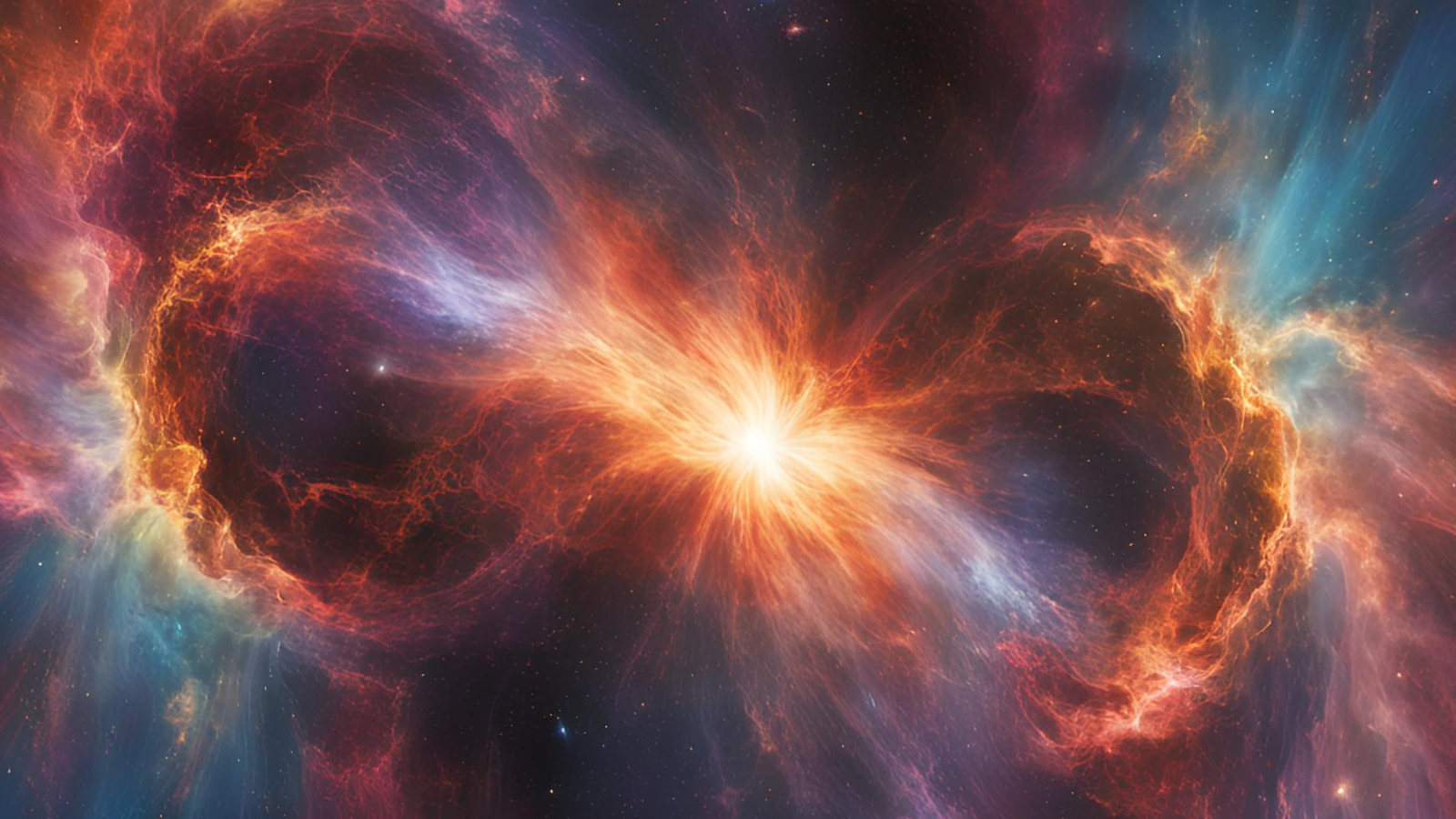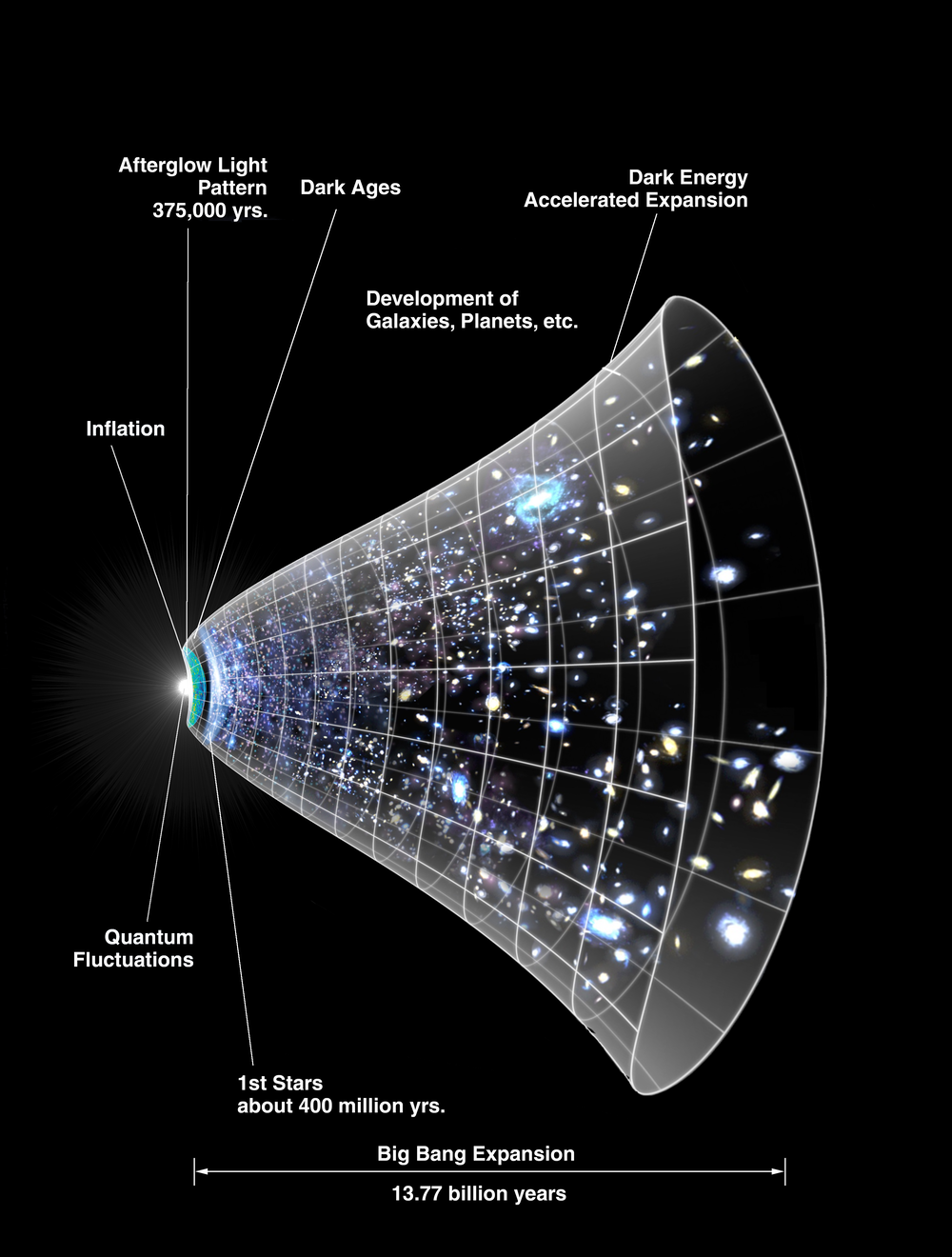Was 2024 the year we finally started to understand dark energy?
"Up to this year, most observations were consistent, with dark energy being the cosmological constant. Nonetheless, 2024 was full of hints pointing out this might not be the case."

2024 was a big year for space science in many ways, but it may well prove to be the most important year for the universe's most troubling and mysterious "ingredient," dark energy, since its discovery almost three decades ago. This was the first year that scientists got an exciting observational hint that the force driving the accelerating expansion of the cosmos could be "growing up."
Dark energy is a serious problem for scientists. Representing 68% of the universe's total matter-energy budget, this is the force that drives the acceleration of the expansion of the universe. This phenomenon is separate from the early inflation of the universe driven by the Big Bang, which had almost drawn to a halt when dark energy took over!
To see why that is worrying, imagine giving a child on a swing a single push, watching their motion come to a halt, and then, for no discernible reason, they start swinging again, and this motion gets faster and faster.
This late-time acceleration was discovered in 1998 by two teams of astronomers making distance measurements using supernovas in faraway galaxies. "Dark energy" was just a placeholder name granted to the force driving this acceleration, with the hope that, eventually, a more accurate concept and name would emerge.
Related: What is dark energy?
Yet dark energy has remained in our recipe of the universe, its presence acting as a reminder that the main ingredient of the cosmos remains a mystery. You can compare this to Colonel Sanders' secret blend of herbs and spices, but it's more like eating at KFC and not knowing what chicken is or where it came from! Troubling indeed.
Though 2024 didn't deliver a more conclusive answer to this mystery than any of the 25 years before it, a significant chink has appeared in the armor of dark energy, a tantalizing hint that could put scientists on the right path to solving this pressing cosmological puzzle.
Get the Space.com Newsletter
Breaking space news, the latest updates on rocket launches, skywatching events and more!
2024 was DESI's year
These new dark energy hints came as a result of the first year of data delivered by the Dark Energy Spectroscopic Instrument (DESI), which resulted in one of the deepest maps of the cosmos ever constructed.
The 5,000 robotic eyes of DESI collect light from millions of galaxies across over a third of the sky over Earth, breaking this down into a spectrum of colors. DESI data have allowed scientists to measure the change in the wavelengths of light from distant galaxies as they are carried away from us on the expanding fabric of space-time, a phenomenon called "redshift."
DESI's results gave scientists a hint that dark energy is changing over time. In particular, it appears that this mysterious force is weakening.
This is significant, as in our current best model of cosmology — the Standard Model or the Lambda Cold Dark Matter (LCDM) model — dark energy is represented by the cosmological constant (marked by the Greek letter lambda). The cosmological constant is supposed to be constant over time in the LCDM model.
"The release of these results was a great day for cosmology, pointing to a 'decreasing' effect of the dark energy over time, meaning it is evolving and, therefore, not constant after all," Luz Ángela García Peñaloza, former DESI team member and a cosmologist at the Universidad ECCI in Colombia, told Space.com in April 2024 when the DESI data dropped. "The discovery of evolving dark energy would be as revolutionary as the discovery of the accelerated expansion of the universe itself if confirmed with future data."
Space.com caught up with García Peñaloza to reflect on the impact of this discovery further and to discuss how cosmologists of the future may look back at 2024.
"Up to this year, most observations were consistent, with dark energy being the cosmological constant. Nonetheless, 2024 was full of hints pointing out this might not be the case," García Peñaloza said. "A number of cosmic surveys have disfavored the cosmological constant, and instead, they are showing promising results for dark energy to evolve in time."
Dark energy gets dynamic!
The hint that dark energy could be weakening, or changing in any way, was a real shock to cosmologists. As García Peñaloza pointed out, until now, observations have been consistent with an "equation of state" for the universe in which the cosmological constant and, thus, dark energy are constant over time.
García Peñaloza said that this diversion from that consistency "opens the window" to models of the cosmos that include a type of dark energy that varies with time. That could mean the end of the cosmological constant and the emergence of "dynamical dark energy."
One dynamical dark energy idea that was favored by García Peñaloza even before the DESI results became available was an "early dark energy" (EDE) model. This idea revolves around the fact that, though dark energy dominates the universe now, that wasn't always the case.
Until around 4 billion to 5 billion years ago, matter had dominated the universe, and before that, radiation driving BIg Bang-related inflation had ruled supreme. EDE models suggest that dark energy didn't just come from nowhere to start ruling the cosmos when it was between 9 and 10 billion years old; dark energy had been there all along, playing a non-negligible role.
That means it is dynamic and changing. The first DESI data seems to back that concept.
Related: What is the Big Bang theory?

Cosmologists won't be too sad to see the end of the cosmological constant, if it turns out that dark energy is indeed evolving.
Predictions of the cosmological constant representing the "vacuum energy" of space made using theory vary from observations of this value by as much as 10 to the power 121 (that's 10 followed by 120 zeroes).
It is little wonder that the cosmological constant has been a headache for cosmologists for decades and has been described as "the worst theoretical prediction in the history of physics."
Let's not wipe lambda off the table too quickly, though. More data will be needed to overturn this model. And data that could do that is already on the way!

The DESI survey began operating from the Mayall Telescope on top of Kitt Peak near Tucson, Arizona, in 2021, and it is set to operate for five years, concluding in 2026. Excitingly, the results we've discussed already hint at a paradigm shift for dark energy science that emerged from just the first year of results.
To trigger a major dark energy rethink, scientists will need to see more data suggesting this cosmos ingredient changes with time. Fortunately, the DESI Year 2 and Year 3 data are expected in Spring 2025.
"Dynamical dark energy could be more compatible with DESI Year 1 observations than the cosmological constant is," García Peñaloza said. "That being said, it is not yet conclusive; they are only hints favoring dark energy as an evolving [phenomenon] than the standard cosmological candidate. Yet, it is quite exciting.
"Perhaps it is still too early to say we are solving this mystery, but I would say that we now know a bit more about the behavior of this unknown ingredient."
García Peñaloza explained what developments in dark energy science she is anticipating next year. DESI will be getting some help in its quest to reveal the secrets of dark energy, she said, in the form of further data from the Euclid space telescope.
The European Space Agency's (ESA's) "dark energy detective" launched in July 2023, and since October of that year, it has been blowing scientists away with its stunning images of the cosmos. Next year, it could do the same with some hard data.
"First, Euclid will be releasing the first data sets, which has been long expected from the community. Also, other proxies of the universe at large scales will be publishing their results that complement recent discoveries from the James Webb Space Telescope," García Peñaloza concluded. "The most updated high-resolution numerical simulations will continue to open new hints on what dark energy is and probably open new questions we don't know about the link of dark energy with other cosmological phenomena."
Like the universe itself, our excitement for 2025 and the science it will deliver is growing at an accelerating pace!
Join our Space Forums to keep talking space on the latest missions, night sky and more! And if you have a news tip, correction or comment, let us know at: community@space.com.

Robert Lea is a science journalist in the U.K. whose articles have been published in Physics World, New Scientist, Astronomy Magazine, All About Space, Newsweek and ZME Science. He also writes about science communication for Elsevier and the European Journal of Physics. Rob holds a bachelor of science degree in physics and astronomy from the U.K.’s Open University. Follow him on Twitter @sciencef1rst.
-
Zdepthcharge Well... Maybe. The Timescape paper is certainly the largest advancement in "dark energy" research we've had since the whole idea was introduced. And for those that are living in the dark, the Timescape paper, simplified, says that the calculations that led people to dark energy were made in error. There is no dark energy.Reply -
contrarian Reply
It certainly seems questionable.Zdepthcharge said:There is no dark energy.
But then you read about changes : "That means it is dynamic and changing."
If the expansion rate is changing, there must be some dynamic explanation, it would seem. Could it be related to mass of the universe - perhaps something about its total mass, or something about gravity that is unknown to us?
Who else is contrarian on this one? -
Unclear Engineer "Changing dark energy" is just one more leap down the rabbit hole of adding unexplained forces and materials to make the theory calculations match the observations where the known physics do not provide any way to make a match.Reply
Science does have a history of making advances in knowledge by observing such mismatches and using them to look into something more closely, leading to the discovery of "new" physical laws. Special Relativity is a prime example of a successful theory that resulted that way.
On the other hand, when the same theory has come to the point that it is dependent on 20 times more mass and energy than we can detect or explain, and we still need to add the assumption that the unknown energy behaves in different manners at different times, science also has a history of that being a serious red flag that the theory is not correct.
So, I do applaud the theorists who are trying to think outside of "the box" that the Lambda-Cold-Dark-Matter model of cosmology has become. -
Torbjorn Larsson The article does not describe new research that would reject LCDM. On the contrary, the latest DESI results confirms LCDM (so general relativity). None of the deviations (apart from the usual cosmic ladder methods giving Hubble tension) reaches 3σ significance. “The statistical significance of the differences compared to DESI, calculated as described above, stands at 1.6σ for PantheonPlus, 2.0σ for Union3, and 2.6σ for DESY5.”Reply
Evolving dark energy is more of the same: “The modified gravity model gives results discrepant with ΛCDM at the 2.4σ level, while for w0waCDM it is at 2.5σ, based on the best-fit χ^2 values."
For those who are living in the dark, the idea that Timescape rests on was rejected 20 years ago and is made in error. There is no viable 'Timescape', as the lead cosmologist on its rejection explains:Zdepthcharge said:Well... Maybe. The Timescape paper is certainly the largest advancement in "dark energy" research we've had since the whole idea was introduced. And for those that are living in the dark, the Timescape paper, simplified, says that the calculations that led people to dark energy were made in error. There is no dark energy.
After performing those calculations — not just with a first-order or second-order approximation, but taking into account fully nonlinear inhomogeneities — a number of lessons emerge.
It turns out that inhomogeneities, as a function of energy density, always remain small: no greater than about ~0.1% (or 1-part-in-1000) of the total energy density at any time, even many billions of years into the future.
It also turns out that there’s a “key scale” where the greatest contributions arise: on scales of between about a few hundred thousand and around ten million light-years. Both larger and smaller cosmic scales, even including super-horizon scales, contribute less.
And finally, it turns out that the inhomogeneities never behave as dark energy behaves, and in fact has an equation of state that always contributes further to a decelerating universe, not an accelerating one.“The possibility that a known component of the universe may be responsible for the accelerated expansion remains intriguing. However, we conclude that sub-horizon perturbations are not a viable candidate for explaining the accelerated expansion of the universe.”
https://bigthink.com/starts-with-a-bang/lumpy-explain-dark-energy/
The expert on this also points out that Wiltshire is a known fringe scientist that has taken a stand on this for decades.
But that expert also takes a more lenient stance on the purported testing in the latest "Timescape" paper than I did when I read it naively. In effect the model introduces a new parameter - backreaction, which we have yet to observe - and we can expect it to fit better. The paper test verifies that it does so but doesn't make a model comparison of both quality (minimal set of parameters) and fit, for example using the Akaike information criterion (AIC). https://en.wikipedia.org/wiki/Akaike_information_criterion
I agree with the part on the proposal of dynamic dark energy as it has a lot to prove (see above on the same point on model comparison for backreaction), But not this part since LCDM is so far the simplest model - and for comparison, with 5 parameters the LCDM era is simpler than the 6 parameter inflation era preceding it - and we have both detected dark matter and vacuum "dark" energy by many different means which has enabled description.Unclear Engineer said:On the other hand, when the same theory has come to the point that it is dependent on 20 times more mass and energy than we can detect or explain,
Specifically for vacuum energy the list of detections goes from spontaneous emission over Lamb shift to late era cosmological expansion. https://en.wikipedia.org/wiki/Vacuum_energy Its description comes from effective quantum field theory (existence) in combination with inflation theory (magnitude, from Weinberg's prediction of its value in anthropic inflationary multiverses). -
TallDave The hit piece on Wiltshire is a bit silly. First off, the "expert" cites obsolete data on density variations from 2005, before most of the very large cosmic structures had been detected. Then he goes off on a weird tangent about a study he co-authored 20 years ago with no relevance to timescape theory. Finally, he implies Wiltshire is fringe even though everything he's done fits neatly within relativity without requiring any "dark" forces or modifications to gravity, and is based on theoretically well-established equations published by Buchert decades ago.Reply
The criticism that it "adds another parameter" is also nonsense. FLRW is an approximation of GR, used because flat space is much easier to calculate. The bits they're ignoring either matter, or they don't. LCDM says they're small enough to ignore. Timescape says they aren't. But no one argues they don't exist. Nor does data contradicting a constant dark energy "confirm" LCDM just because it hasn't yet disproved it to 5 sigmas.
The Euclid 1A/BAO results will be detailed enough to either confirm or disprove timescape (maybe by this summer), but LCDM's days are numbered regardless. It isn't just dark energy fluctuations and Hubble tension, it's too-early galaxies, too-large cosmic structures, and local (non-Copernican) Keplerian decline in the Milky Way (all of which may be explainable in timescape). At some point, some better explanation needs to be found.
